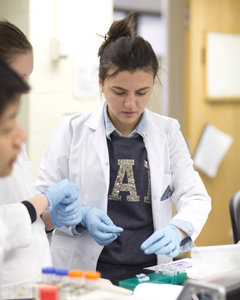Sep 10 2015
A Clarkson University chemistry doctoral student has received an Eastern Analytical Symposium (EAS) Graduate Student Research Award for her design and development of a portable aptasensor for rapid visual detection of mycotoxin contamination.

Gonca Bulbul of Istanbul, Turkey, is developing a portable detection method of Ochratoxin A, a type of mycotoxin. Mycotoxins are produced by some species of mold and can cause health problems.
This new detection method uses aptamer conjugated nanoparticles as colorimetric probes, which change color due to mycotoxin contamination and enable a rapid visual detection of Ochratoxin A without any need for elaborate laboratory equipment. This method also provides other advantages such as ease of operation and low cost.
"It can be portable and it takes much less time than the conventional method," she said.
Bulbul has worked on this research with her advisor, Egon Matijevic Chair of Chemistry and Professor of Chemistry & Biomolecular Science Silvana Andreescu, and postdoctoral fellow Akhtar Hayat. They will continue the research by using the system to detect other contaminants and test real field samples.
The EAS Student Awards program recognizes students involved in research in the broad field of analytical chemistry who demonstrate special talent in research. Bulbul's award will cover her participation at the EAS Analytical Symposium in November at the Garden State Exhibit Center in Somerset, N.J., where she will have the opportunity to present a poster and share her work with other researchers.
Clarkson University launches leaders into the global economy. One in five alumni already leads as a CEO, VP or equivalent senior executive of a company. Located just outside the Adirondack Park in Potsdam, N.Y., Clarkson is a nationally recognized research university for undergraduates with select graduate programs in signature areas of academic excellence directed toward the world’s pressing issues. Through 50 rigorous programs of study in engineering, business, arts, sciences and the health professions, the entire learning-living community spans boundaries across disciplines, nations and cultures to build powers of observation, challenge the status quo, and connect discovery and engineering innovation with enterprise.